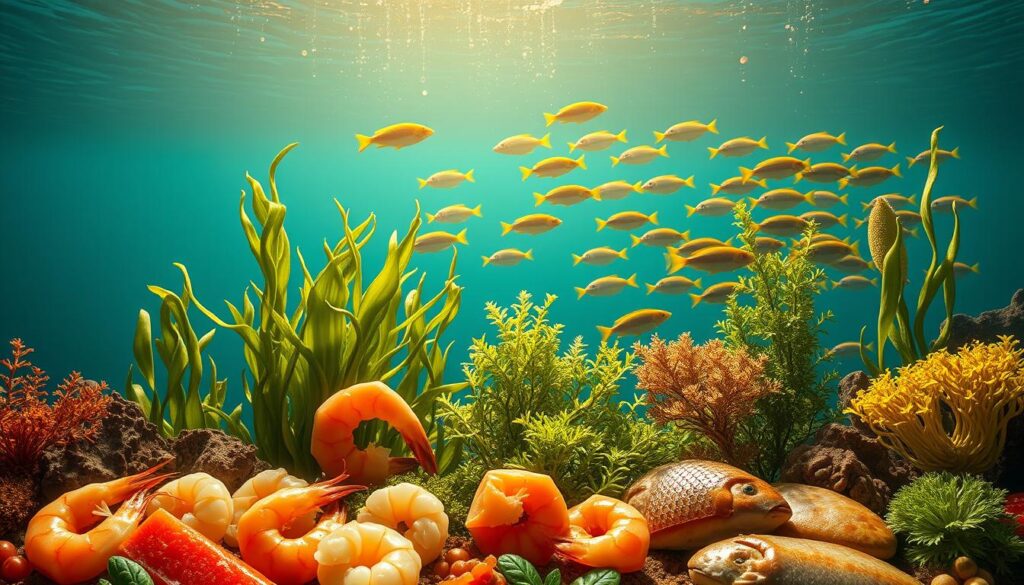When you think about your next meal, do you consider its impact on our oceans? The health and welfare of billions of people depend on ecologically diverse and stable oceans. With seafood demand set to rise by about 30 percent by 2030, finding sustainable options is key.
So, what does this mean for you? The bright side is that plant-based seafood options are becoming a tasty and eco-friendly choice over traditional seafood. This change helps the planet and lets you make a difference with what you eat.
Key Takeaways
- The global demand for seafood is increasing, necessitating sustainable alternatives.
- Plant-based seafood is a promising solution that is both delicious and environmentally friendly.
- Adopting vegan seafood options can contribute to the health of our oceans.
- Sustainable seafood alternatives can help reduce the environmental impact of the seafood industry.
- Making informed dietary choices can positively impact the planet.
What is Plant-Based Seafood?
Plant-based seafood is changing how we see seafood. It’s a meatless seafood option that tastes and feels like real seafood. More people want eco-friendly seafood as they care more about the planet.
Plant-based seafood comes from plants, not fish. It’s made to look and taste like seafood. This is for those who want to eat less meat or try new foods.
Definition and Overview
Plant-based seafood is a seafood substitute made from plants. It’s made from plant ingredients that taste and feel like real seafood. This is for people who want to eat less meat or care about the environment.
This seafood alternative is for many people. It’s not just for vegetarians and vegans. It’s also for those who want to eat less meat or care about the planet.
Key Ingredients in Plant-Based Seafood
The secret to good plant-based fish is the right ingredients. Soy, seaweed, yeast, legumes, and vegetable oils are common. They’re chosen for taste, texture, and nutrition.
- Soy: Rich in protein and versatile.
- Seaweed: Adds seafood flavor and nutrients.
- Yeast: Gives umami flavor and nutrition.
- Legumes: Add protein and texture.
- Vegetable oils and starches: Help with taste and texture.
By mixing these ingredients, makers create many meatless seafood options. As technology improves, we’ll see even better plant-based seafood.
The Rise of Plant-Based Seafood in the Market
More people want to eat sustainably, leading to a rise in plant-based seafood. You’re part of a growing group that wants tasty meals that also care for the planet and animals.
The market for plant-based seafood is booming. This is because you’re looking for products that are good for the environment. You’re choosing these options because of worries about overfishing and the damage to marine ecosystems.
Trends Driving Popularity
Several trends are making plant-based seafood more popular. People are now more aware of the harm traditional seafood causes, like overfishing and habitat destruction. Plant-based seafood is seen as a sustainable seafood choice that helps protect marine resources.
There’s also a growing need for vegetarian seafood that’s both healthy and eco-friendly. You want products that taste great and help make the food system better.
- Growing consumer awareness of environmental issues
- Increasing demand for sustainable and eco-friendly products
- Rising popularity of plant-based diets
Consumer Demand and Preferences
Your tastes are changing to include more sustainable and ethical options. The demand for plant-powered seafood and cruelty-free seafood is increasing. You’re looking for products without animal products or by-products.
Companies are responding by creating more plant-based seafood alternatives. These products aim to taste and feel like traditional seafood. This makes it easier for you to switch.
The growth of plant-based seafood shows it’s more than a trend. It’s a movement towards a better food system. By choosing these products, you’re helping make a difference.
Benefits of Plant-Based Seafood
The move towards plant-based seafood is driven by its many benefits. These include health perks and helping the environment. As people learn more about their food choices, eco-friendly seafood options are becoming more popular.
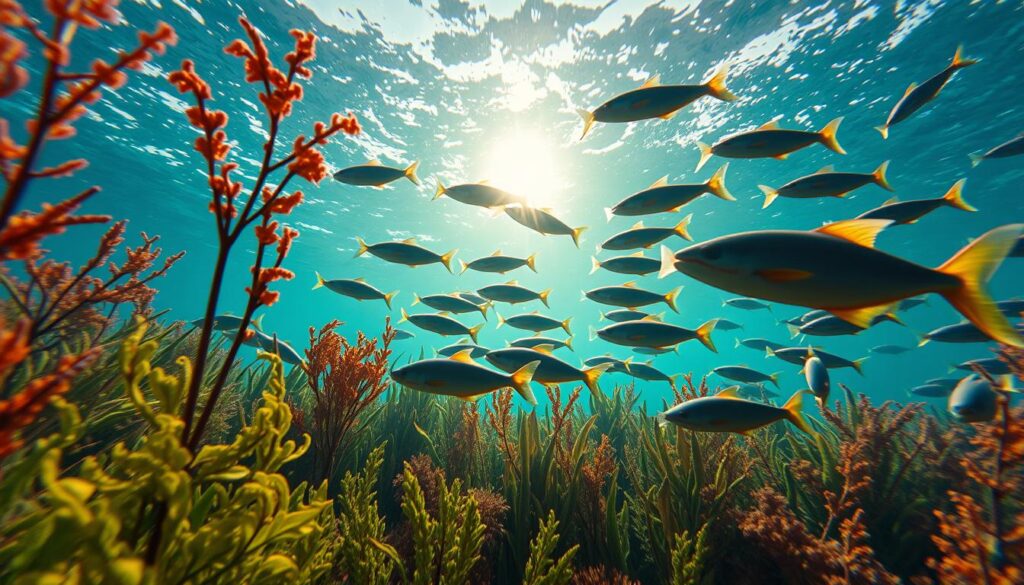
Health Advantages
Choosing plant-based seafood means less mercury and toxins. This is good news for your health. Plus, it often has less fat and more nutrients.
It’s also great for those with seafood allergies. Plant-based seafood mimics the taste and texture of real seafood. This way, you can enjoy a wide variety of dishes without health risks.
Environmental Impact
The environmental benefits of sustainable seafood are huge. Traditional seafood production harms the planet. It leads to more greenhouse gases, overfishing, and pollution.
Plant-based seafood is better for the planet. It needs less energy and water and makes fewer emissions. By picking eco-friendly seafood, you help the environment. This choice supports a greener food system.
In summary, plant-based seafood is good for you and the planet. Adding these options to your diet helps create a more sustainable food future.
Nutritional Value of Plant-Based Seafood
Exploring plant-based seafood is exciting. It’s important to know its nutritional value. This type of seafood can be a healthy choice, providing many benefits.
Key Nutrients in Plant-Based Options
Plant-based seafood often has important nutrients. These include omega-3 fatty acids, vitamin B12, and iron. These are good for your heart, brain, and blood.
When picking plant-based seafood, look for these nutrients. This ensures you get the most health benefits.
Comparing Nutritional Profiles
Plant-based seafood and traditional seafood have different nutritional profiles. Traditional seafood is often high in protein and omega-3s but may have more mercury. Plant-based seafood, on the other hand, is lower in calories and fats, making it better for your heart.
But, the nutritional content can vary. It depends on the ingredients and how it’s made. Always check the labels.
Also, consider where the ingredients come from and how the product is made. Choosing products from trusted brands ensures you get a high-quality, nutritious option.
Popular Plant-Based Seafood Products
Now, you can find plant-based seafood products that are both sustainable and tasty. The market is growing fast. Many top brands offer a wide range of choices.
Leading Brands and Offerings
Top brands in the plant-based seafood market focus on vegan fish sticks, seafood alternatives, and sushi-grade items. They’re known for making products that taste and feel like real seafood.
- Vegan fish sticks made from plant-based ingredients
- Seafood alternatives that mimic the taste of fish and shellfish
- Sushi-grade products that are perfect for sushi lovers
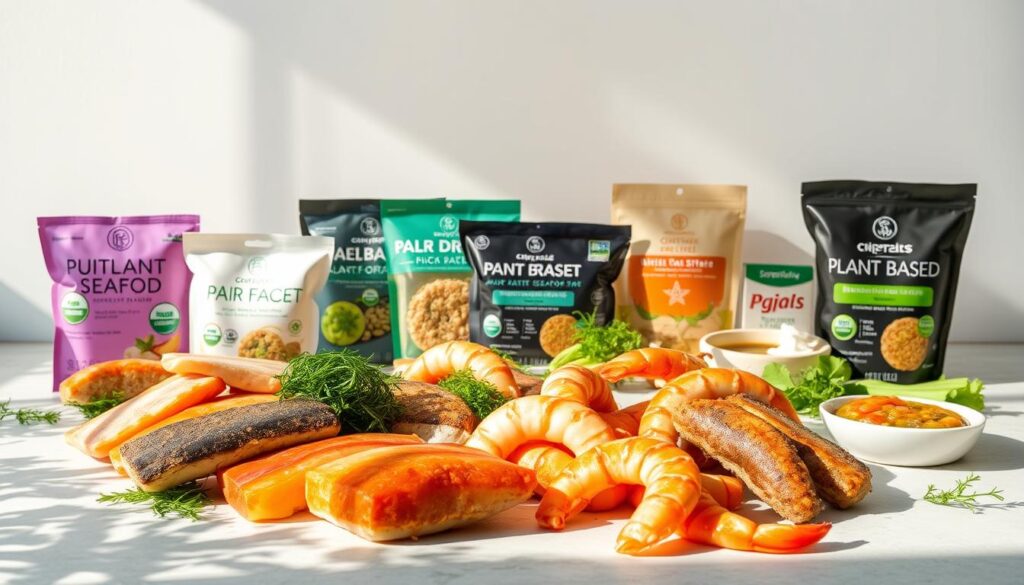
Unique Flavors and Varieties
The vegan seafood products today come in many flavors and types. They cater to all tastes and preferences. You can find:
- Smoky flavors that replicate the taste of grilled seafood
- Herb-infused flavors that add a fresh twist to traditional seafood dishes
- Spicy flavors that add a kick to your meals
These products are not just good for the planet. They also offer a tasty and varied way to enjoy your meals.
How to Cook Plant-Based Seafood
Cooking plant-based seafood is easy and fun. Whether you’re a pro or new to cooking, you’ll enjoy making plant-based seafood dishes. It’s a simple way to add variety to your meals.
Cooking Techniques and Tips
There are many ways to cook plant-based seafood. You can grill, bake, or sauté it to get the right taste and texture. For grilling, heat your grill to medium-high and cook for 3-4 minutes on each side.
Baking is a healthy choice. Season your seafood, put it on a baking sheet, and bake at 400°F (200°C) for 10-12 minutes. This method ensures it’s cooked through.
When sautéing, use a non-stick pan with a bit of oil over medium heat. Cook your seafood for 3-4 minutes on each side until it’s golden. Try different marinades and seasonings to make your dishes even tastier.
Recipe Ideas to Try
Plant-based seafood is great for many dishes, like sushi and fish tacos. Here are some ideas to start with:
- Vegan sushi rolls with plant-based salmon
- Plant-based fish tacos with avocado salsa
- Grilled plant-based shrimp skewers with a citrus marinade
Here’s a simple vegan fish and chips recipe using plant-based cod:
| Ingredient | Quantity |
|---|---|
| Plant-based cod | 1 package |
| Breading mix | 1 cup |
| Oil for frying | As needed |
To make, coat the cod in breading mix and fry in hot oil until golden. Serve with fries or coleslaw for a tasty meal.
Sustainability and Ethical Considerations
Plant-based seafood is becoming more popular as people want a greener food system. They’re looking for eco-friendly seafood options because of the environmental impact of their food choices.
Eco-Friendly Practices in Production
Plant-based seafood uses eco-friendly methods that are better for the planet than traditional seafood. These methods include:
- Using plant-based ingredients that need less water and land
- Lowering greenhouse gas emissions by using less energy
- Reducing waste by using all parts of the plant
These practices help make plant-based seafood more sustainable. They also set a new standard for eco-friendly production.
Impact on Marine Life Conservation
Choosing plant-based seafood helps marine life. It reduces the need for catching wild fish. This helps fish populations recover and keeps biodiversity strong.
| Conservation Benefit | Description | Impact |
|---|---|---|
| Reduced Overfishing | Lower demand for wild-caught seafood | Allows fish stocks to recover |
| Preservation of Marine Biodiversity | Less habitat destruction from fishing gear | Maintains ecosystem balance |
| Decreased By-Catch | Avoidance of non-target species capture | Protects vulnerable species |
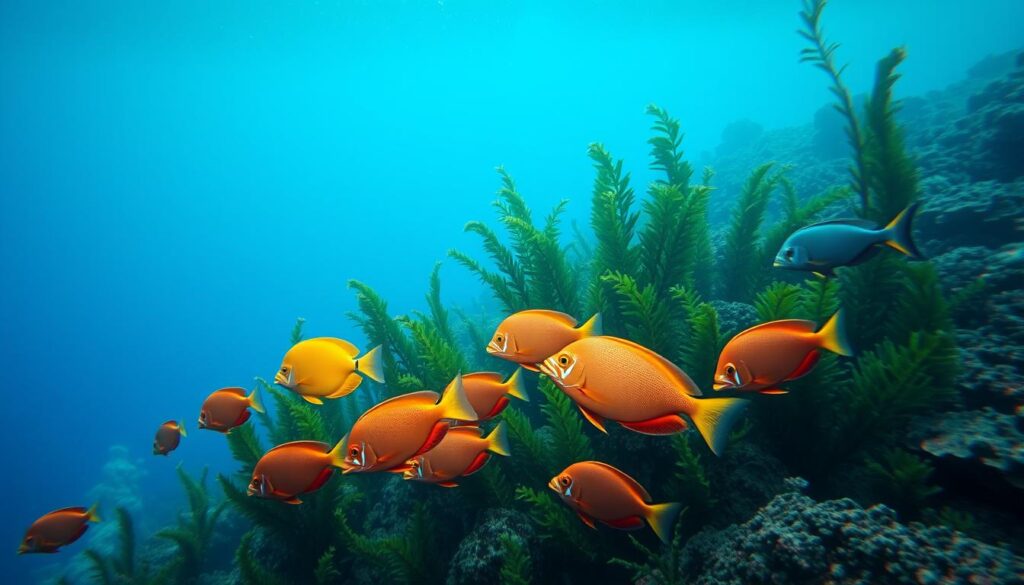
The table shows how plant-based seafood helps marine life. It’s not just good for the planet. It also helps keep our oceans healthy.
Choosing plant-based seafood is a step towards a better food system. As the industry grows, we’ll see more green and ethical practices.
Addressing Common Myths About Plant-Based Seafood
Plant-based seafood is getting more popular, but myths about it are common. These myths include worries about taste, texture, and nutrition. It’s important to know what’s true and what’s not.
Taste and Texture Concerns
Many people think plant-based seafood tastes and feels different from real seafood. But, thanks to new food tech, these products now taste and feel very similar. They’re getting closer to the real thing.
“The innovation in plant-based seafood is remarkable, with products that are not only sustainable but also delicious and convincing in texture.”
Some brands use legume proteins and seaweed extracts. They make products that are almost the same as real seafood.
Nutritional Myths Debunked
Some think plant-based seafood isn’t as nutritious as real seafood. But, many plant-based options are packed with nutrients. They have omega-3 fatty acids, vitamin B12, and selenium, just like fish.
| Nutrient | Traditional Seafood | Plant-Based Seafood |
|---|---|---|
| Protein | High | High |
| Omega-3 Fatty Acids | High | Fortified Options Available |
| Vitamin B12 | High | Fortified Options Available |
Plant-based seafood can be a healthy choice. It offers the same nutrients as real seafood, if you pick the right options.
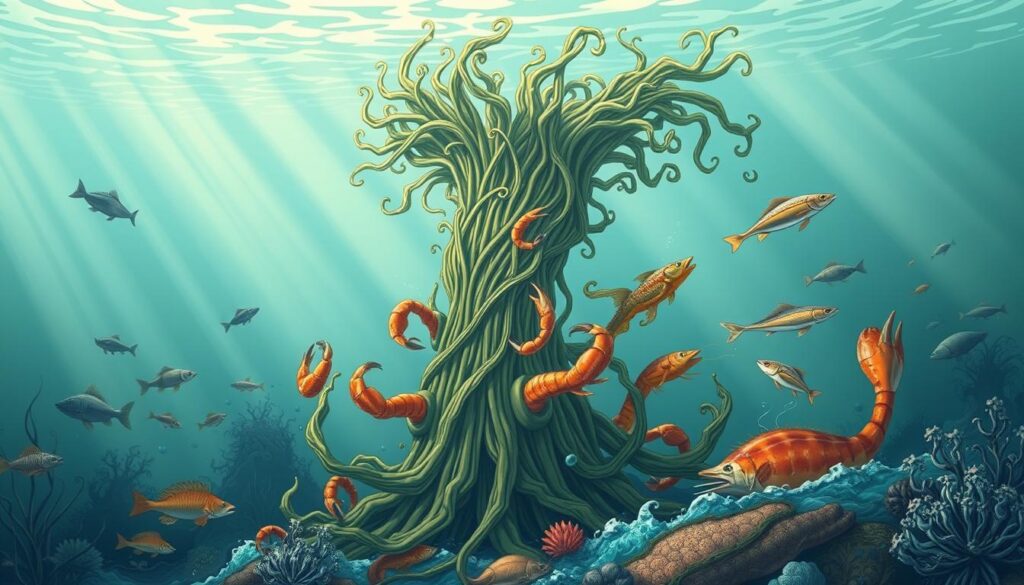
The Future of Plant-Based Seafood
The plant-based seafood market is on the verge of a big change. This change comes from new tech and what people want to eat. It shows that seafood’s future is all about new ideas and caring for our planet.
Innovations and Technological Advances
New tech is making plant-based seafood better. Companies can now make products that taste and feel like real seafood. These products also have more nutrients. Advances in food technology have made plant-based seafood more advanced.
Some big changes include:
- Improved texture through new processing methods
- New plant-based ingredients that taste better and are healthier
- Precision fermentation to make seafood-like products
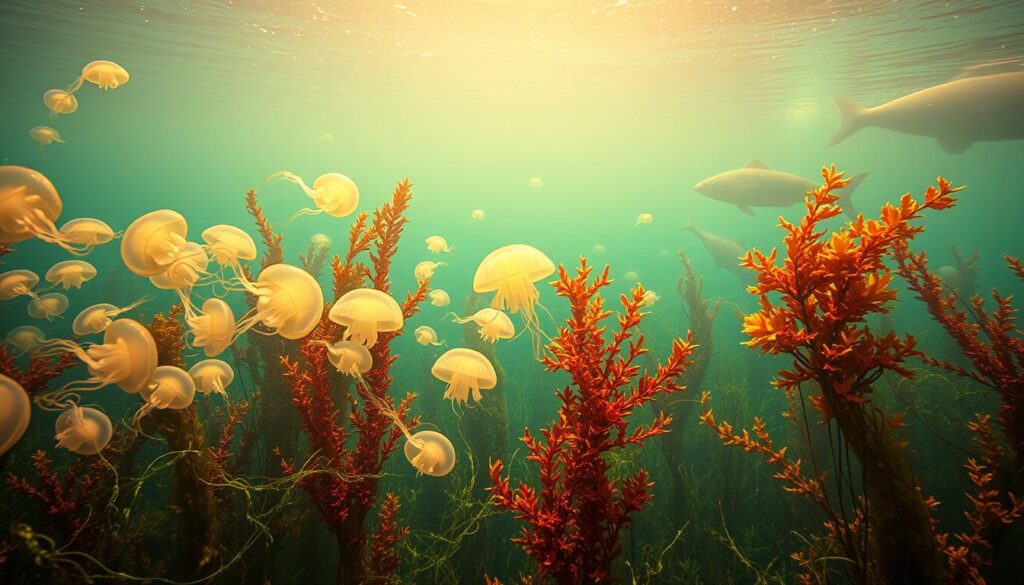
Market Predictions and Growth
The plant-based seafood market is set to grow a lot. People want food that’s good for the planet and their health. Market analysts predict this market will keep growing as more people choose vegan or flexitarian diets.
| Year | Market Size | Growth Rate |
|---|---|---|
| 2023 | $1.2 billion | 10% |
| 2025 | $1.8 billion | 12% |
| 2030 | $3.5 billion | 15% |
As the market grows, we’ll see more new products and brands. This will keep driving growth and innovation in plant-based seafood.
Plant-Based Seafood in Restaurants
The rise of plant-based seafood is changing how we eat out. More restaurants now offer vegan seafood choices. This is because people want to eat in a way that’s better for the planet.
How Dining Out is Changing
Going out to eat is now about more than just taste. It’s about making choices that are good for the environment and animals. Restaurants are adding plant-based seafood to their menus. This makes it easy to enjoy seafood without feeling guilty about it.
Vegan seafood options are getting better all the time. Restaurants now offer vegan versions of seafood favorites. You can find everything from vegan “fish” and chips to plant-based sushi. This trend is all about creating new, tasty, and eco-friendly dining experiences.

Notable Restaurants Serving Plant-Based Seafood
Some restaurants are at the forefront of plant-based seafood. They serve vegan “scallops” made from mushrooms and plant-based “fish” burgers. These dishes are so good, they appeal to everyone, not just vegans and vegetarians.
Now, when you go out to eat, you’ll find lots of plant-based seafood options. This change is making dining out more inclusive and sustainable. It’s easier than ever to choose meals that are good for you and the planet.
How to Incorporate Plant-Based Seafood into Your Diet
Plant-based seafood is a great choice for a healthy diet. It’s easy to add to your meals. With a bit of planning, you can enjoy its benefits and keep your diet varied and nutritious.
Meal Planning Tips
Begin by planning meals with seasonal produce and your favorite recipes. Swap traditional seafood with plant-based options in pasta, stir-fries, and salads. This makes it simple to include plant-based seafood in your diet.
- Start with simple recipes that use plant-based seafood as the main ingredient.
- Experiment with different brands and types of plant-based seafood to find your favorite.
- Pair plant-based seafood with a variety of vegetables and whole grains for balanced meals.
For instance, try a vegan seafood paella. Use plant-based seafood and add your favorite vegetables for a tasty dish.
Creative Pairings with Other Foods
Plant-based seafood is very versatile. You can mix it with many foods to make healthy and tasty meals. Here are some ideas:
| Plant-Based Seafood | Pairing Options | Meal Ideas |
|---|---|---|
| Vegan shrimp | Pasta, garlic, lemon | Shrimp scampi pasta |
| Plant-based salmon | Quinoa, roasted vegetables, avocado | Salmon salad bowl |
| Vegan crab | Corn, black beans, salsa | Crab and corn salad |
Chef Chloe Coscarelli says, “Plant-based seafood is not just a substitute; it’s an opportunity to create innovative and delicious dishes that everyone can enjoy.”
“The versatility of plant-based seafood allows for endless creativity in the kitchen, making it easy to cater to diverse tastes and dietary preferences.”

Adding plant-based seafood to your diet is a healthy choice. It also helps the environment. With these tips, you can explore new flavors and recipes while making a positive impact.
Cost Comparison: Plant-Based vs. Traditional Seafood
When shopping for seafood, knowing the price difference between plant-based and traditional options is key. The cost of seafood, whether it’s plant-based or traditional, plays a big role in our choices.
The prices of these alternatives can change based on several things. These include the brand, type of product, and how it’s made. Usually, the cost of plant-based seafood is about the same as traditional seafood.
Understanding Price Points
Many things affect the final cost of both plant-based and traditional seafood. For plant-based seafood, these include:
- The cost of raw materials and ingredients
- Production processes, including manufacturing and packaging
- Research and development expenses for product innovation
- Marketing and distribution costs
Traditional seafood prices are influenced by other factors. These include:
- Fishing or farming costs, including labor and equipment
- Processing and packaging expenses
- Regulatory compliance and sustainability measures
- Global demand and supply chain logistics
Value for Your Money
When comparing plant-based and traditional seafood, think about the value for your money. Look at the price, nutritional benefits, environmental impact, and quality of the product.
Plant-based seafood often has a green edge and might be safer from mercury and other contaminants. 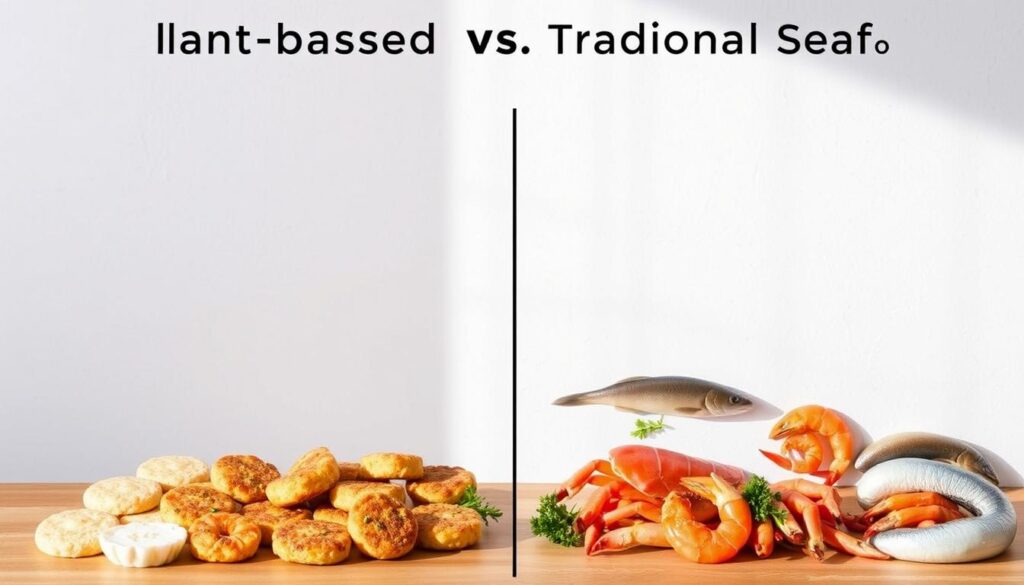
Consumers should consider these points when deciding. This helps them choose the best option for their budget, health, and the planet.
Plant-Based Seafood and Allergies
If you’re allergic to seafood, you might wonder if plant-based seafood is safe. Plant-based seafood is made from plants, which could be safe for those with seafood allergies. But, it’s important to know the risks and benefits.
Allergen-Free Options
Many plant-based seafood products are made to be safe for those with dietary restrictions. They use ingredients like legumes, grains, and vegetables. For example, some use pea or soy protein to feel like seafood.
When looking for plant-based seafood, find products labeled as “allergen-friendly” or “free from common allergens.” Manufacturers often provide allergen warnings on packaging. Always check the ingredient list to avoid allergens you’re sensitive to.
Common allergen-free ingredients in plant-based seafood include:
- Legumes (e.g., peas, lentils)
- Grains (e.g., rice, quinoa)
- Vegetables (e.g., mushrooms, seaweed)
- Nuts and seeds (e.g., almonds, sesame seeds)
Addressing Cross-Contamination Concerns
Even though plant-based seafood doesn’t have seafood allergens, there’s a risk of cross-contamination. This can happen if the factory also handles seafood or other allergens. To avoid this, pick products from manufacturers with strict safety rules and dedicated facilities for plant-based products.
Some makers follow strict standards to avoid cross-contamination. They might use Good Manufacturing Practices (GMPs) and regular audits to ensure they follow allergen control policies.
| Manufacturer | Allergen Control Measures | Dedicated Facility |
|---|---|---|
| Brand A | GMPs, Regular Audits | Yes |
| Brand B | GMPs, Allergen Testing | No |
| Brand C | Strict Segregation, Regular Cleaning | Yes |
Exploring plant-based seafood options? Knowing about cross-contamination and choosing trusted brands can help you make safe choices for your diet.
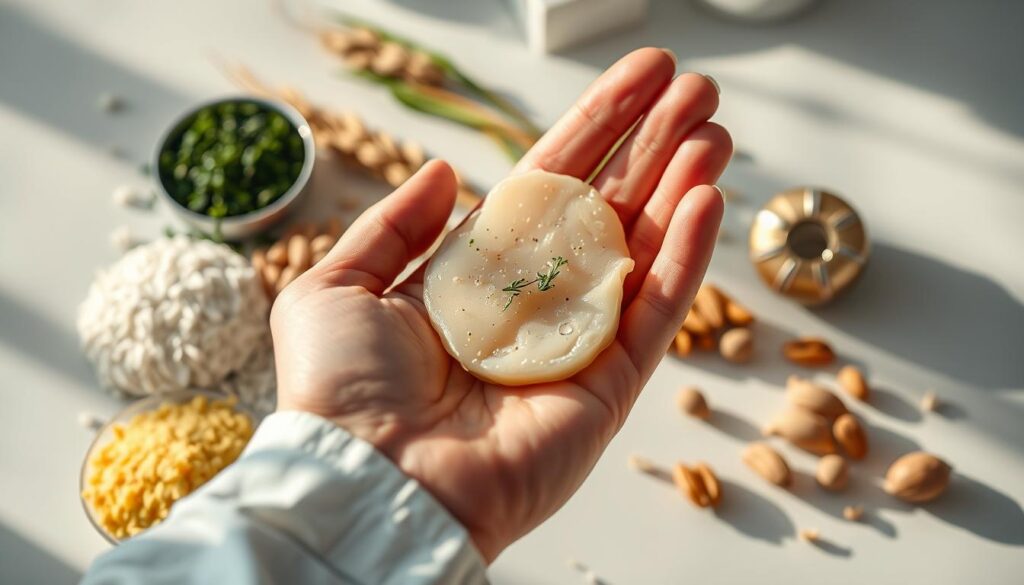
Grocery Shopping for Plant-Based Seafood
Shopping for plant-based seafood is now easier than ever. You can find a wide range of products in major retailers. This makes it simpler to adopt a sustainable and potentially healthier diet.
Where to Find These Products
Plant-based seafood products are now available in many grocery stores across the United States. You can usually find them in these sections:
- Specialty or Health Food Sections: Stores now have sections for plant-based or vegan products. Here, you can find a variety of seafood alternatives.
- Freezer Sections: Frozen plant-based seafood products are common. They offer convenience and a longer shelf life.
- Refrigerated Sections: Some stores carry refrigerated plant-based seafood. These are often made from tofu or legumes.
- Online Retailers: Online shopping is also an option. Many retailers offer plant-based seafood options for home delivery or in-store pickup.
Tips for Choosing Quality Items
When picking plant-based seafood, keep these tips in mind for high-quality products:
- Check the Ingredients: Choose products made from sustainable, non-GMO ingredients. Look for Non-GMO Project Verified or Vegan Society logos.
- Minimal Processing: Opt for products with fewer, recognizable ingredients and minimal processing. This is often healthier and better for the environment.
- Nutritional Content: Check the nutritional label to see if the product meets your dietary needs. Many plant-based seafood options are fortified with vitamins and minerals.
- Brand Transparency: Pick brands that are open about their sourcing, manufacturing, and sustainability practices.
By following these tips, you can make smart choices when buying plant-based seafood. This supports your health and the environment.
The Role of Plant-Based Seafood in Climate Change Mitigation
Plant-based seafood is becoming a key player in fighting climate change. More people are choosing it because they know it’s better for the planet. This shift is driven by growing awareness of the environmental impact of our food.
Seafood production harms the environment in many ways. It leads to overfishing, destroys habitats, and releases greenhouse gases. By picking plant-based seafood, you help cut down on these problems.
Carbon Footprint Reduction
Plant-based seafood can greatly reduce the carbon footprint of the seafood industry. Traditional seafood production is complex and emits a lot of greenhouse gases. But, making plant-based seafood needs less energy and resources, making it more eco-friendly.
Comparative Carbon Footprint Analysis
| Product | Carbon Footprint (kg CO2e per kg) |
|---|---|
| Traditional Salmon | 5.3 |
| Plant-Based Salmon | 2.1 |
| Traditional Shrimp | 4.8 |
| Plant-Based Shrimp | 1.9 |
Supporting Sustainable Fisheries
Choosing plant-based seafood also helps sustainable fisheries. The demand for wild-caught seafood can harm fish populations. Plant-based seafood is a better choice, helping to protect fish stocks and support sustainable fishing.
As we face climate change, plant-based seafood’s role will grow. By choosing what we eat, we can help make our food system more sustainable.
Testimonials from Plant-Based Seafood Consumers
Plant-based seafood is getting more popular. People love its taste and how it’s good for the planet. Their stories show how great it is.
Personal Stories and Experiences
Many have shared their journey with plant-based seafood. They say it’s better for their health and the planet. For example, one person said, “
‘I’ve been using plant-based seafood alternatives for a few months now, and I’ve noticed a significant improvement in my overall health and wellbeing.’
” This shows how it can change lives for the better.
Others find it easy to add plant-based seafood to their meals. “Eating plant-based seafood has become a staple in my household,” says another. “It’s easy to prepare, tastes great, and I feel good about what I’m putting into my body.” These stories show its practical benefits.
Community Feedback on Taste and Benefits
People love plant-based seafood for its taste and health benefits. They say it’s delicious and healthier than regular seafood. “The taste is surprisingly close to the real thing,” says a happy customer. “I’ve been able to enjoy my favorite seafood dishes without the guilt.“
Reviews show that people like its convenience, taste, and health perks. They mention its lower environmental impact, better nutrition, and lack of common allergens. As demand grows, so does its appeal.
In summary, testimonials show a big shift towards healthier eating. As more people share their good experiences, plant-based seafood will likely keep gaining popularity.
Conclusion: Embracing Plant-Based Seafood for a Better Future
Plant-based seafood offers many benefits, like being good for the environment and healthy for you. It’s great for your health and helps our planet too. Choosing plant-based seafood means you’re supporting a greener food system.
Plant-based seafood also opens up new flavors and recipes for you to try. There are many products and flavors out there. You can easily add them to your meals.
As more people want healthy and sustainable food, choosing plant-based seafood is key. It’s a step towards a better future for our planet. Try out different plant-based seafood products and recipes to see the benefits for yourself.
FAQ
What is plant-based seafood?
Is plant-based seafood a healthy alternative to traditional seafood?
How does plant-based seafood impact the environment?
Can I cook plant-based seafood like traditional seafood?
Is plant-based seafood suitable for people with seafood allergies?
How do I choose high-quality plant-based seafood products?
Can plant-based seafood help mitigate climate change?
Is plant-based seafood more expensive than traditional seafood?
Where can I find plant-based seafood products?
How can I incorporate plant-based seafood into my diet?
Plant-Based Crab Cakes
Equipment
- Mixing bowl
- Skillet
- Spatula
- Measuring cups and spoons
Ingredients
- 1 can (14 oz) hearts of palm drained and chopped
- 1 cup cooked chickpeas mashed
- ¼ cup vegan mayonnaise
- ¼ cup breadcrumbs plus more for coating
- 2 tbsp diced red bell pepper
- 2 tbsp diced celery
- 2 tbsp chopped green onion
- 1 tbsp Dijon mustard
- 1 tsp Old Bay seasoning
- ½ tsp smoked paprika
- ½ tsp sea salt
- ¼ tsp black pepper
- 2 tbsp olive oil for pan-frying
Instructions
- In a large bowl, combine hearts of palm, mashed chickpeas, vegan mayo, breadcrumbs, bell pepper, celery, green onion, Dijon mustard, Old Bay, smoked paprika, salt, and pepper.
- Mix until well combined, then form into 6 patties. Coat each patty lightly with extra breadcrumbs.
- Heat olive oil in a skillet over medium heat. Cook patties for 3-4 minutes per side, until golden brown and heated through.
- Serve warm with vegan tartar sauce, lemon wedges, or a fresh salad.

